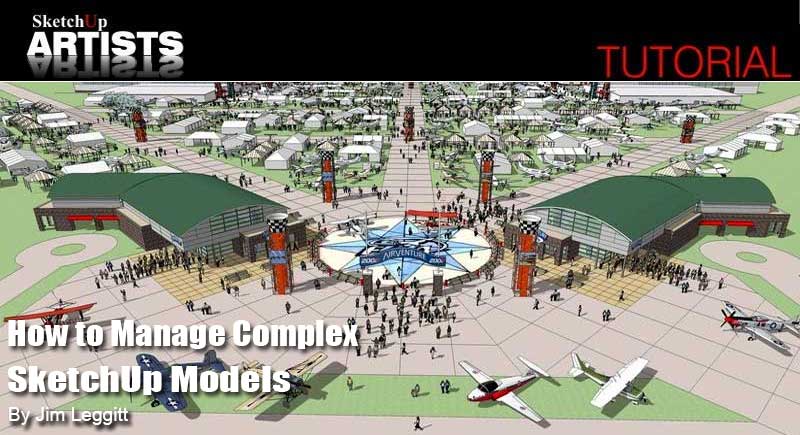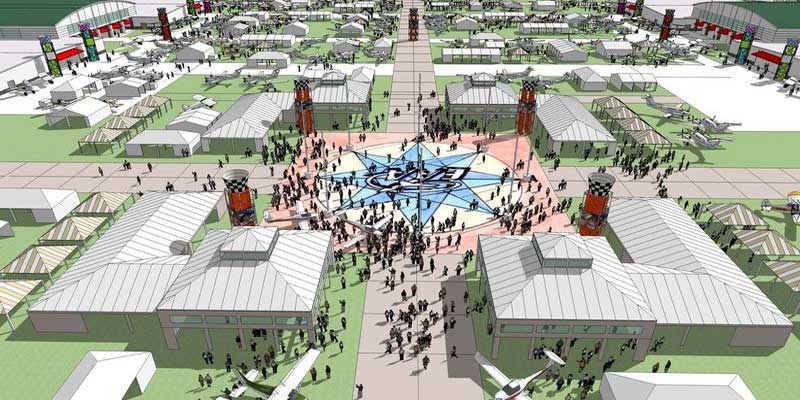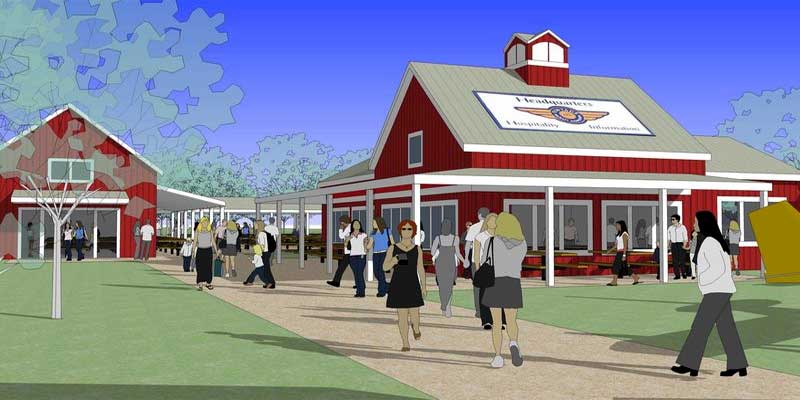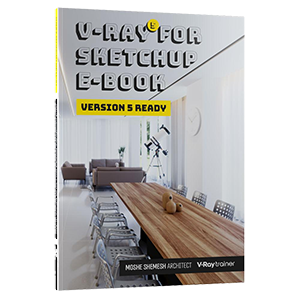How to Manage Complex SketchUp Models

By Jim Leggitt
Have you ever found yourself in digital quicksand modeling with SketchUp? I have! A model that has an excessive number of components, a lot of building detail and too much site area is the perfect candidate for bogging down your computer and wasting a lot of your valuable time. Here are some helpful tips on how to manage the digital model information and give you the results you deserve after investing your creative savings into the model.
The model I am using for this example is one that I constructed during a design charrette for the master plan of the Oshkosh Wisconsin EAA Air Show. The original model (shown below) focused on the overall layout of the fair grounds, with an emphasis on the main entry plaza and administration buildings. Exhibit tents and large hangar buildings are seen in the distance.
1. Work with Layers – separating the people, planes, buildings, towers and other components on different layers which can be turned on and off to make navigation through the model easier.
When I began to study specific sub areas within the master plan, it became clear that I would need more detailed design within the overall master SketchUp model. This was accomplished by making a second copy of the original model and deleting all model information not visible in the scene.
2. Clone the Master Model – creating multiple sub models that focus on specific areas within the master plan. I created five sub models each representing a detailed look at some of the themed areas within the plan, i.e., Exhibit Halls, Crossroads, Vendor Pavilions, Red Barn Restaurant and Warbird Cafe. Those model views are shown below:
.
These complex models and the resulting views were detailed enough to show the client and communicate the design intent of the master plan. Although the airplanes were highly detailed models I downloaded from 3D Warehouse, the people and landscaping were 2D. Buildings were “stage set” models with minimal detail.
3. Limit Use of 3D Components – your model with suffer if you overdose with 3D components, especially 3D trees. When building complex SketchUp models, try to stay completely away from any 3D components. Finally, mix up your model views with a variety of aerial and eye level views.
4. Add a Variety of Scenes – the aerial views add context and clarity of the master plan while the eye level views add necessary scale and human character.
I hope these tips were helpful. Good luck building your next big model!
Jim
To learn more about modeling with SketchUp, look for Jim Leggitt’s book Drawing Shortcuts or visit his website www.drawingshortcuts.com.
















great and verrry handy mini tutorial mate, Thanx
” When building complex SketchUp models, try to stay completely away from any 3D components.”
Could you clarify? I thought that the point of 2d or 3d components was to reduce file size and optimize the model structure?
Also, regarding the create clones of the master model, are you saying you copy the overall plan, and add detail to the specific area you want to focus on for the sub-model? Did you then link that detail back to the original model using components?
Thanks for a very helpful tutorial
can exchange any face model to my demand photo
short but helpul..very nice..thank you..god bless you.
RE: 3. Limit Use of 3D Components
I tried to do so with a Sketchup file of 40MB.
I erased all 3d components imported from 3d Warehouse.
The size of the file stayed the same.
Anyways, what is the point of having the 3d Warehouse if you can’t use them?
It seems that I should skip to some more serious software like Revit.
Best wishes.
Hi Raynold
A lot of the stuff on 3D Warehouse is not good quality models (there are some) and takes a lot of time to clean up and modify to your own liking…betterto model your own from scratch. As far as your model file size not changing , try purging it, you will find it makes a difference then 🙂
It is very helpful. I appreciate your sharing it . Please continue. Is there a free source to get good stuff for hospital interiors ?
Hi Jim,
For complex 3D meshes, you might also try decimation.
We develop Polygon Cruncher and 3DBrowser.
These software can open a Sketchup file, simplify it, then save it back to the Sketchup format. Depending on your mesh, Polygon Cruncher can remove 80% of the polygons.
Reducing polygon counts could be an alternative way to manage complex models.
You may have a look at http://www.mootools.com
Thanks,
Manuel